#kuchikamisake
Explore tagged Tumblr posts
Photo
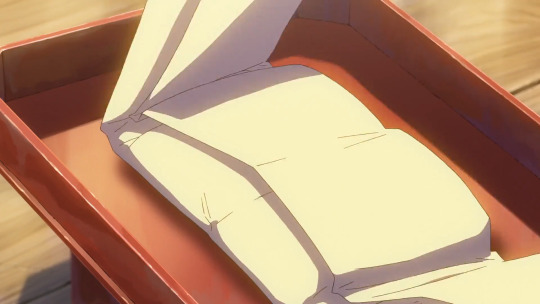
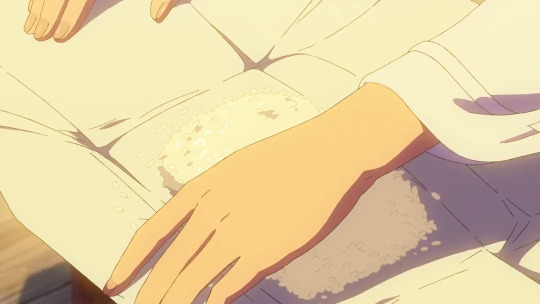
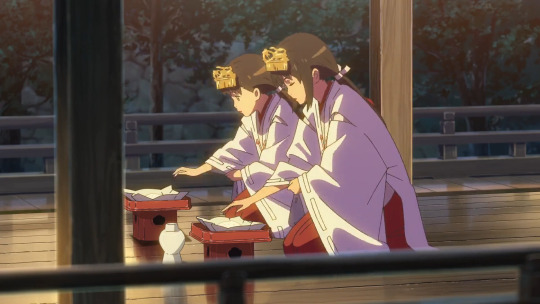
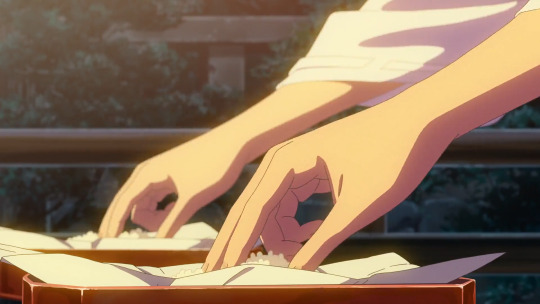
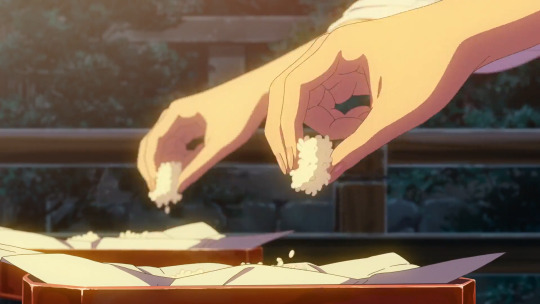
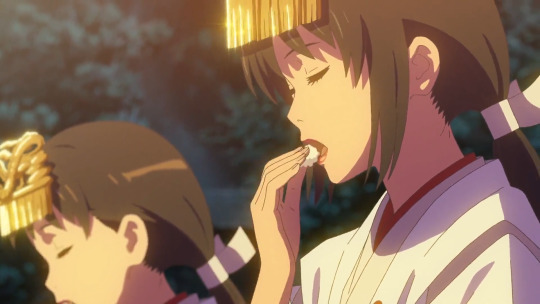

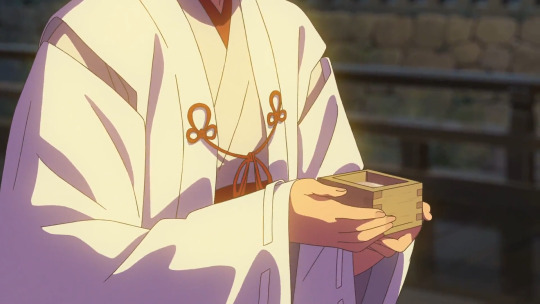
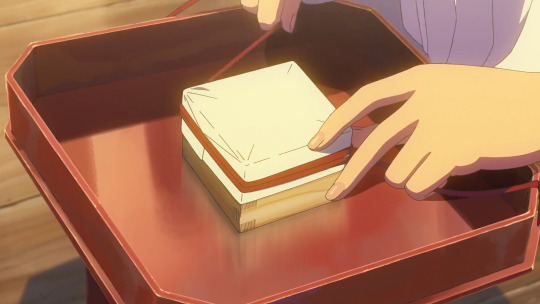
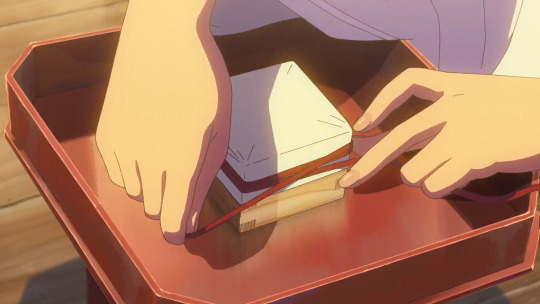
Mitsuha + Yotsuha making kuchikamisake / Kimi no Na wa (2016)
2 notes
·
View notes
Note
fake follower

I don't even follow you?!?! Literally WHO ARE YOU
2 notes
·
View notes
Text
still thinking about the american live action remake of kimi no na wa… since in the anime itomori is a lake town, is the live action itomori going to be situated in the great lakes region? we know taki will be a chicago boy while mitsuha will be a small town native american girl— is she anishinaabe? which indigenous beliefs and concepts can even substitute japanese shintoism? what will replace musubi, kuchikamisake, and the red string of fate? will this be another ‘mystical native x civilized white’ story?

#kimi no na wa#mitsuha miyamizu#taki tachibana#i want it to do well because i want the cast & crew & audience to have a good movie but.. i am confusion#i don’t think you could even do this sort of culture swap with korea and china & they’re much more similar place to japan than the US#mytext
3 notes
·
View notes
Text
Anime doesn't equal Japanese culture
I think we've heard this statement a lot. I mean, anime is just fiction and so it's free to mend reality to fit the story it's trying to tell. And some anime fans would be surprised to know that real Japanese people can act a lot differently than anime characters.
But...
... at least personally, I think this statement simply isn't true in some cases. Anime is indeed able to teach us something about the Japanese culture.
We have these:
Chihayafuru
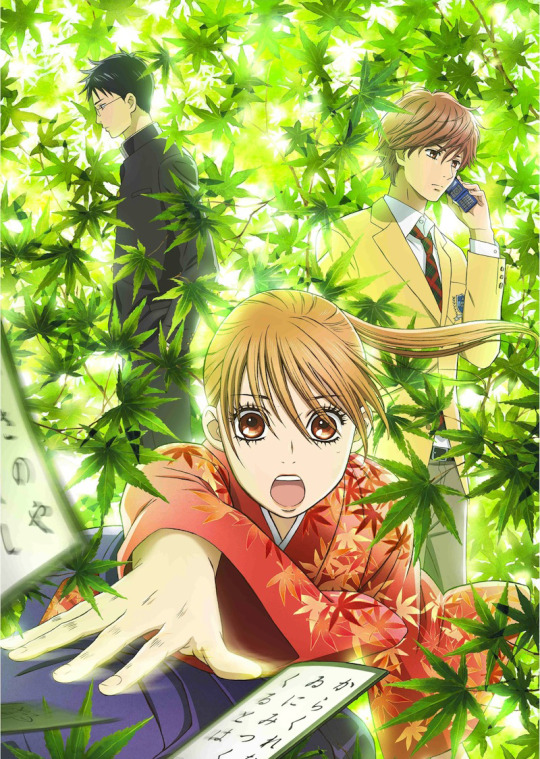
Chihayafuru introduced me to the world of Karuta, a traditional Japanese card game, which is something I didn't even know existed. The anime (and manga) is featuring real shrines and places in order to make it feel as real as possible. It even made me watch a real queen match on YouTube because I fell in love with it. And not only that - it boosted the profile of competitive karuta in Japan and overseas.
Truly a masterful representation of Japanese culture.
Kono Oto Tomare!

This anime introduced me to koto - a traditional Japanese string instrument, which is something I, again, didn't even know existed, making me and millions of other fans watch real koto performances. And if it wasn't for this anime I'd completely missed it. Now, I can't stop listening to it. Goddammit, anime!
Tsurune

Putting KyoAni drama of just-friendship between cute anime boys aside, Tsurune introduced me to Kyudo - Japanese archery. Now, I'm not stupid and I knew what archery was before but I certainly didn't know that Japan developed its own traditions around a simple bow and arrow. And it certainly was fascinating seeing how competitions work and what goes into it and I'm thankful for that.
Barakamon
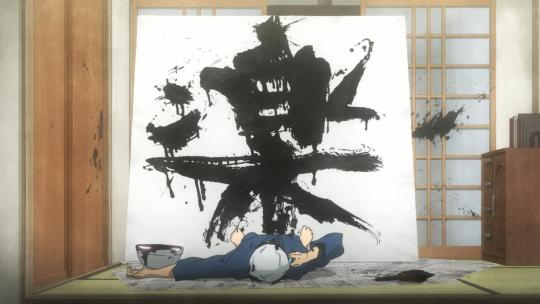
Barakamon isn't even trying to introduce you to the world of Japanese calligraphy. The story focuses heavily on character development and not on the traditional art itself but seeing the main character desperately trying to find his own style or teaching children how to write beautifully in order to win a school competition still managed to leave an impact on me and taught me something new about the Japanese culture.
And there are many more
Noragami, Kamisama Hajimemashita and Natsume Yuujinchou introduced me to the world of Youkai, Ayakashi and Japanese gods and while I know that the authors made their stories unique and they aren't 100% accurate to the real legends, they still count.
Kimi no Na wa shows a traditional shrine dance during which maidens make Kuchikamisake. Not to mention the hundreds of other anime which show a simple visit to a shrine like Hyouka.
Shougi - a Japanese strategic game similar to our chess is featured in a lot of anime - the most popular being Naruto.
And don't even make me talk about the food.
What I'm trying to say is...
...anime did introduce us to Japanese culture and while it isn't the best representation there is, we shouldn't take away the credit it deserves and appreciate it.
#anime#japanese culture#chihayafuru#karuta#kono oto tomare!#koto#tsurune#kyuudo#barakamon#calligraphy#noragami#kamisama hajimemashita#natsume yuujinchou#kimi no na wa#hyouka#naruto#youkai#ayakashi#gods#shougi
6K notes
·
View notes
Text
Taki drank Mitsuha's kuchikamisake, they became one, and through Mushubi he time traveled and they rescued 500 people from the comet.
13 notes
·
View notes
Text
ok theory. mitsuha & taki met again when they're adults bc taki drank mitsu's kuchikamisake w/c is the other half of mitsu's soul. so in short, connected na sila before by let's say the gods/fate but the connection was made stronger by the sake.
8 notes
·
View notes
Text
Your Name and Foucalt’s Method
“Just a small town girl, living in a lonely world; she took the midnight train, going anywhere.”
-Journey
Shinkai’s Your Name is a piece that has gained recognition since it’s release in 2016. Although some of the non-linear scenes may be confusing to some viewers initially, they become clear as the film progresses, giving it a unique viewing quality. Furthermore, I appreciate that the film, through visuals, character expressions, body language, and dialogue, is able to show the viewer what is happening. A personal pet peeve of mine is when anime tends to fall into a trap of relying on narrating their plot points to clarify, and Your Name masterfully avoids this.
A prevalent moral of the piece was the importance of tradition, of holding the knowledge and responsibility of where one comes from. Mitsuha’s grandmother raises her grandchildren into their particularly religious household, and without this perpetuation of tradition, Taki may not have understood the cycle of what was happening. Listening to Mitsuha’s grandmother was what made him realize that the comet and the bodyswitching were events that had happened before, and thus enabled him and Mitsuha to save the people of the town. Mitsuha’s somewhat distant father presents the opposite of this, only concerned with his immediate life, and not the bigger picture of what has occurred over the course of thousands of years that allow him to live his aforementioned life. Furthermore, Mitsuha’s classmates gossiped about her creation of kuchikamisake, despite the fact they were also present at the ceremony. These characteristics kept her father and classmates too worldly, and if not for the more ascendant Mitsuha and Taki, they would have perished without warning.
Thankfully, however, the Mayor presumably issues a warning to evacuate, as all of the citizens are saved. Despite his past actions in largely leaving his daughters (to be fair, while he was grieving for his wife), he realizes the most fundamental element of tradition, that of family. One’s family is one of the most important means of how tradition is perpetuated, and the Mayor decides in the end, to follow his family, Mitsuha.
One of my favorite things about this film was the way the characters were animated. We are able to tell when Mitsuha was in Taki’s body and vice versa, because of how the characters were animated. This didn’t necessarily go so far as harmful gender roles, but rather subconscious actions that most people aren’t even aware of. Taki’s body takes on a more feminine gait when Mitsuha is occupying it, and Taki doesn’t know how to replicate Mitsuha’s detailed hairstyle.
Another small but significant detail was that of the comet, Tiamat. A quick Google search tells me that in ancient Babylonian mythology, Tiamat was a goddess of creation and chaos. These conflicting attributes hone in to the deity of this piece, which places an emphasis on the connection of things that don’t seem related, like the country girl in a small town and the budding architect of Tokyo.
With all of these characteristics in mind, I feel that the main moral of Your Name was the bumbling manner of the human experience, and its duality. There are things beyond human understanding, the fact that we seem to be subject to the whims of both fate and coincidence, and our only chance of gaining a footing is by learning from our forefathers, while still having the independence to forge our own path.
2 notes
·
View notes
Text
Apr. 10 - Your Name
This is I think the third time I have watched Makoto Shinkai’s Your Name. Although I do think the visuals of this anime is superb, I still find it difficult to wrap my head around the timeline of events in the show.
What stood out to me in Your Name is the rejection of traditional life in favor of a modern one. Early on, Mitsuha is shown to be sick of her current lifestyle. Living in a rural area, she finds it boring because her city is small, shops close early and there are no cafes. Mitsuha doesn’t seem to like practicing the traditions passed down in her family either. For example, after she makes the kuchikamisake while her friends observe, she is embarrassed and later shouts “I hate this life!”. When Mitsuha switches body with Taki however, she enjoys her life living in Tokyo. Mitsuha’s father is similar in this respect. Instead of continuing the Miyamizu family traditions, he chooses to become a politician. Although I’m not entirely sure, I think the anime favors traditional life. I say this not only because the grandmother rebukes the father for becoming a politician, but also because the kuchikamisake that was made in the traditional ceremony became the key to saving Itomori.
Something else that caught my attention is how people reacted to the characters after they switched bodies. When Mitsuha is in Taki’s body, Okudera says to Mitsuha, “I like you better today. Never knew you had a feminine side.” Mitsuha is even able to help Taki go on a date with Okudera. On the other hand, while Taki is in Mitsuha’s body, he helps Mitsuha become popular, to the point that a boy and even a girl confesses his/her love to him. It’s interesting how Mitsuha, who displays her feminine side while in Taki, and Taki, who displays his masculine side in Mitsuha, can gain popularity. This is different from Nitori from Wandering Son, who is punished for not performing according to his gender. The difference could be due to their outward appearances, since Mitsuha and Taki still dressed normally.
2 notes
·
View notes
Text
MUSE AS A DEITY rules: think carefully about your character & their development through their journey ( canon or oc ) within their story. fill out the chart & tag whoever you want!

DEITY OF \ time travel, entangled destiny, broken souls, split hearts, purification but not purity.
ASSOCIATED WITH \ knotted red cords, fractured mirrors, the last stick of incense in a container, geodes that are only partly open, three-eyed crows, white crows.
SACRED PLANTS, FUNGI & TREES \ white sage, red poppies, camellia, hyssop, passiflora.
SACRED STONES & GEMS \ geodes (cracked or uncracked), apache tears, gold obsidian, shungite, labradorite
SACRED ANIMALS \ white crows, pudu, kingfishers
COLORS \ pale blue and burgundy/purple mix
FOOD \ red teas, peaches, manuka honey, passionfruit, dragonfruit, smooth groundcherry, mangosteen
SCENTS \ burning saltwater logs, caramelizing sugar, fermenting honey ginger, rust.
ACCEPTED OFFERINGS \ knotted rope crafts, kuchikamisake, unbroken geodes, small plants that are newly made, blown crackle glass.
WAYS TO HONOUR \ seizing the moment, admitting love regardless of consequences, protecting the innocent, taking heavy burdens from those who don’t deserve pain. swearing to a promise and upholding it at all costs, promises that go beyond a lifetime, honor for sacrifice, protection for the defenseless.
tagged by: lovingly thrown at me by one (1) @kenkaze (thank you!!!) tagging: @wingbladed, @sunpierce, @ofalsehoods, @betterhealing
#ғɪʀsᴛ ᴏғ ʜᴇʀ ᴋɪɴᴅ.original poster#ᴡʀɪᴛᴛᴇɴ ʀᴇᴘᴏʀᴛs.text#ᴘʀᴇss ᴇɴᴛᴇʀ ᴛᴏ sᴛᴀʀᴛ.ooc#ʙᴏᴜɴ���ᴇʀ.headcanon#ᴄᴀsɪɴᴏ ᴛɪᴍᴇ.meme#[GOD i love this meme]#[I spent all day working on this tbh]
3 notes
·
View notes
Text
Kimi no Na wa. (Your Name.)
Simply diving into a review immediately after watching a film as devastatingly gorgeous and emotionally affecting as Kimi no Na wa is probably not a great idea, but this is an anime review blog, so here goes.
Kimi no Na wa isn’t just a charming body-swap rom-com, or a time-travelling odyssey, or a disaster prevention caper, or a tale of impossibly cruel temporal and physical distance between two soul mates, or a reflection on the fragility and impermanence of everything from memories to cities, or a tissue-depleting tearjerker.
It’s all of those things and more. And it’s also one of, if not the best, movies I’ve ever seen, anime or otherwise.
After a cryptic prologue, Kimi no Na wa starts out modestly: Miyamizu Mitsuha, Shinto shrine maiden and daughter of a mayor, has grown restless in her small town world, so one night, shouts out tot he night that she wants to be reborn as a boy in Tokyo.
This, mind you, happens after an odd incident in which Mitsuha essentially lost a day, during which all her family and friends say she was acting very strange and non-Mitsuha-y…like a different person.
That’s because she was. She and a boy from Tokyo, Tachibana Taki, randomly swap bodies every so often when they’re dreaming. As such, they end up in the middle of their couldn’t-be-any-different lives; the only similarity being that both of them yearn for more.
Despite just meeting these characters, watching Mitsuha and Taki stumble through each other’s lives is immensely fun. And because this is a Shinkai film, that enjoyment is augmented by the master director’s preternatural visual sumptuousness and realism. Every frame of Mitsuha’s town and the grand vastness of Tokyo is so full of detail I found myself wanting to linger in all of them.
As the body-swapping continues, the two decide to lay down “ground rules” when in one another’s bodies—albeit rules both either bend or break with impunity—and make intricate reports in one another’s phone diaries detailing their activities during the swaps.
Interestingly, Mitsuha makes more progress with Taki’s restaurant co-worker crush Okudera than Taki (she like’s Taki’s “feminine side”), while the more assertive Taki proves more popular with boys and girls when Taki’s in her body.
Taki happens to be in Mitsuha’s body when her grandmother and sister Yotsuha make the long, epic trek from their home to the resting place of the “body” of their Shinto shrine’s god, an otherworldly place in more ways than one, to make an offering of kuchikamisake (sake made from saliva-fermented rice).
While the three admire the sunset, Mitsuha’s granny takes a good look at her and asks if he, Taki, is dreaming. Just then he wakes up back in his own body to learn Mitsuha has arranged a date with him and Okudera—one she genuinely wanted to attend.
Okudera seems to notice the change in Taki from the one Mitsuha inhabited; she can tell his mind is elsewhere, and even presumes he’s come to like someone else. Taki tries to call that someone else on his phone, but he gets an automated message.
Then, just like that, the body-swapping stops.
After having cut her hair, her red ribbon gone, Mitsuha attends the Autumn Festival with her friends Sayaka and Teshi. They’re treated to a glorious display in the night sky, as the comet Tiamat makes its once-every-1,200-years visit.
Taki decides if he can’t visit Mitsuha’s world in his dreams anymore, he’ll simply have to visit Mitsuha. Only problem is, he doesn’t know exactly what village she lives in. Okudera and one of his high school friends, who are worried about him, decide to tag along on his wild goose chase.
After a day of fruitless searching, Taki’s about to throw in the towel, when one of the proprietors of a restaurant notices his detailed sketch of Mitsuha’s town, recognizing it instantly as Itomori. Itomori…a town made famous when it was utterly destroyed three years ago by a meteor created from a fragment of the comet that fell to earth.
The grim reality that Taki and Mitsuha’s worlds were not in the same timeline is a horrendous gut punch, as is the bleak scenery of the site of the former town. Every lovingly-depicted detail of the town, and all of its unique culture, were blasted into oblivion.
Taki is incredulous (and freaked out), checking his phone for Mitsuha’s reports, but they disappear one by one, like the details of a dream slipping away from one’s memory. Later, Taki checks the register of 500 people who lost their lives in the disaster, and the punches only grow deeper: among the lost are Teshi, Sayaka…and Miyamizu Mitsuha.
After the initial levity of the body-swapping, this realization was a bitter pill to swallow, but would ultimately elevate the film to something far more epic and profound, especially when Taki doesn’t give up trying to somehow go back to the past, get back into Mitsuha’s body, and prevent all those people from getting killed, including her.
The thing that reminds him is the braided cord ribbon around his wrist, given to him at some point in the past by someone he doesn’t remember. He returns to the site where the offering was made to the shrine’s god, drinks the sake made by Mitsuha, stumbles and falls on his back, and sees a depiction of a meteor shower drawn on the cave ceiling.
I haven’t provided stills of the sequence that follows, but suffice it to say it looked and felt different from anything we’d seen and heard prior in the film, and evoked emotion on the same level as the famous flashback in Pixar’s Up. If you can stay dry-eyed during this sequence, good for you; consider a career being a Vulcan.
Taki then wakes up, miraculously back in Mitsuha’s body, and sets to work. The same hustle we saw in Taki’s restaurant job is put to a far more important end: preventing a horrific disaster. The town itself may be doomed—there’s no stopping that comet—but the people don’t have to be.
Convincing anyone that “we’re all going to die unless” is a tall order, but Taki doesn’t waver, formulating a plan with Teshi and Sayaka, and even trying (in vain) to convince Mitsuha’s father, the mayor, to evacuate.
While the stakes couldn’t be higher and the potential devastation still clear in the mind, it’s good to see some fun return. Sayaka’s “we have to save the town” to the shopkeep is a keeper.
Meanwhile, Mitsuha wakes up in the cave in Taki’s body, and is horrified by the results of the meteor strike. She recalls her quick day trip to Tokyo, when she encountered Taki on a subway train, but he didn’t remember her, because it would be three more years before their first swap.
Even so, he can’t help but ask her her name, and she gives it to him, as well as something to remember her by later: her hair ribbon, which he would keep around his wrist from that point on.
Both Taki-as-Mitsuha and Mitsuha-as-Taki finally meet face-to-face, in their proper bodies, thanks to the mysterious power of kataware-doki or twilight. It’s a gloriously-staged, momentous, and hugely gratifying moment…
…But it’s all too brief. Taki is able to write on Mitsuha’s hand, but she only gets one stoke on his when twilight ends, and Taki finds himself back in his body, in his time, still staring down that awful crater where Itomori used to be. And again, like a dream, the more moments pass, the harder it gets for him to remember her.
Back on the night of the Autumn Festival, Mitsuha, back in her time and body, takes over Taki’s evacuation plan. Teshi blows up a power substation with contractor explosives and hacks the town-wide broadcast system, and Sayaka sounds the evacuation. The townsfolk are mostly confused, however, and before long Sayaka is apprehended by authorities, who tell everyone to stay where they are, and Teshi is nabbed by his dad.
With her team out of commission, it’s all up to Mitsuha, who races to her father to make a final plea. On the way, she gets tripped up and takes a nasty spill. In the same timeline, a three-years-younger Taki, her ribbon around his wrist, watches the impossibly gorgeous display in the Tokyo sky as the comet breaks up. Mitsuha looks at her hand and finds that Taki didn’t write his name: he wrote “I love you.”
The meteor falls and unleashes a vast swath of destruction across the landscape, not sparing the horrors of seeing Itomori wiped off the face of the earth—another gut punch. Game Over, too, it would seem. After spending a cold lonely night up atop the former site of the town, he returns to Tokyo and moves on with his life, gradually forgetting all about Mitsuha, but still feeling for all the world like he should be remembering something, that he should be looking for someplace or someone.
Bit by bit, those unknowns start to appear before him; a grown Sayaka and Teshi in a Starbucks; a passing woman with a red ribbon in her hair that makes him pause, just as his walking by makes her pause. But alas, it’s another missed connection; another classic Shinkai move: they may be on the same bridge in Shinjuku, but the distance between them in time and memory remains formidable.
Mitsuha goes job-hunting, enduring one failed interview after another, getting negative feedback about his suit from everyone, including Okudera, now married and hopeful Taki will one day find happiness.
While giving his spiel about why he wants to be an architect, he waxes poetic about building landscapes that leave heartwarming memories, since you’ll never know when such a landscape will suddenly not be there.
A sequence of Winter scenes of Tokyo flash by, and in light of what happened to Itomori quite by chance, that sequence makes a powerful and solemn statement: this is Tokyo, it is massive and complex and full of structures and people and culture found nowhere else in the world, but it is not permanent.
Nothing built by men can stand against the forces of nature and the heavens. All we can do is live among, appreciate, and preseve our works while we can. We’re only human, after all.
And yet, for all that harsh celestial certainty, there is one other thing that isn’t permanent in this film: Taki and Mitsuha’s separation. Eventually, the two find each other through the windows of separate trains, and race to a spot where they experience that odd feeling of knowing each other, while also being reasonably certain they’re strangers.
Taki almost walks away, but turns back and asks if they’ve met before. Mitsuha feels the exact same way, and as tears fill their eyes, Taki asks Mitsuha for her name. Hey, what do you know, a happy ending that feels earned! And a meteor doesn’t fall on Tokyo, which is a huge bonus.
Last August this film was released, and gradually I started to hear rumblings of its quality, and of how it could very well be Shinkai’s Magnum Opus. I went in expecting a lot, and was not disappointed; if anything, I was bowled over by just how good this was.
Many millions of words have been written about Kimi no Na wa long before I finally gave it a watch, but I nevertheless submit this modest, ill-organized collection words and thoughts as a humble tribute to the greatness I’ve just witnessed. I’ll be seeing it again soon.
And if for some reason you haven’t seen it yourself…what are you doing reading this drivel? Find it and watch it at your nearest convenience. You’ll laugh; you’ll cry; you’ll pump your fist in elation.
By: sesameacrylic
1 note
·
View note
Text
Your Name(Kimi nonawa)
Mitsuha Miyamizu: It's really you.
Taki Tachibana: I came to see you. It wasn't easy because you were so far away.
Mitsuha Miyamizu: But how? At that moment, I...
Taki Tachibana: I drank your kuchikamisake.
Mitsuha Miyamizu: You drank that? You idiot! Pervert! Oh yeah, and you touched my boobs!
Taki Tachibana: How do you know that?
Mitsuha Miyamizu: Yotsuha saw it.
Taki Tachibana: Oh! Sorry, I couldn't help it! It was just once.
Mitsuha Miyamizu: Just once? Doesn't how many times! Jerk.
Taki Tachibana: Sorry.
0 notes
Text
Kimi no Na wa, Beautiful Love Story
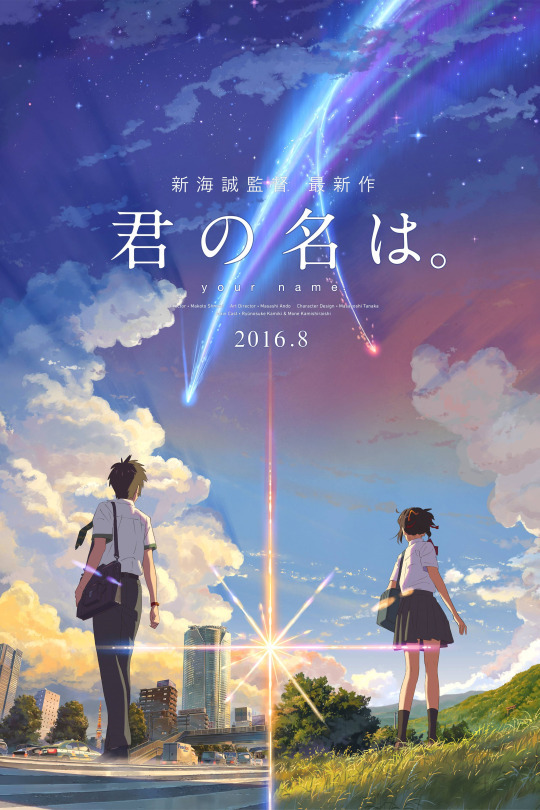
Kimi no Na wa atau yang dikenal dengan judul Your Name adalah salah satu film animasi layar lebar dari Jepang yang menghebohkan khalayak luas, bahkan yang tidak biasa nonton film anime pun. Film ini disutradarai oleh Makoto Shinkai yang dibuat berdasarkan novelnya sendiri yang berjudul sama. Genre fantasi dan romance adalah hal saya sukai jadi saya sendiri sangat hype ketika pertama kali melihat trailer dari film ini, dapet banget feel-nya. Setelah menunggu setahun lamanya akhirnya film ini tayang dan membuat para penontonnya merasakan perasaan yang campur aduk.
Berikut daftar karakter dan pengisi suaranya:
Mitsuha Miyamizu: Mone Kamishiraishi
Taki Tachibana: Ryunosuke Kamiki
Miki Okudera: Masami Nagasawa
Katsuhiko Teshigawara: Ryou Narita
Sayaka Natori: Aoi Yuuki
Tsutomu Fujii: Nobunaga Shimazaki
Masahiro Takagi: Kaito Ishikawa
Yotsuha Miyamizu: Kanon Tani

Inilah kedua tokoh utamanya Mitsuha dan Taki
Sinopsis singkat dari filmnya (SPOILER ALERT):
Mitsuha Miyamizu, seorang siswi SMA yang tinggal disebuah desa bernama Itomori. Mitsuha dan Yotsuha adiknya adalah seorang miko, mereka biasa menenun bersama dengan neneknya. Dan melakukan ritual yang dimana mereka membuat “kuchikamisake” (sake yang dibuat dengan mengunyah nasi, melepehkannya, dan membiarkannya terfermentasi).
Disisi lain Taki Tachibana yang tinggal di kota Tokyo adalah seorang siswa SMA dan pekerja paruh waktu sebagai pelayan disuatu restoran itali.
Suatu hari Mitsuha yang sudah muak dengan kehidupan pedesaan memohon agar ia hidup sebagai lelaki tampan yang hidup di Tokyo pada kehidupan selanjutnya. Kemudian suatu hari Mitsuha bermimpi ia menjalani kehidupan seorang lelaki yang bernama Taki dan begitu pula dengan Taki yang bermimpi menjalani kehidupannya sebagai Mitsuha. Akhirnya mereka menyadari bahwa didalam mimpi itu keduanya saling bertukar jiwa.
Mereka mulai berkomunikasi satu sama lain dengan meninggalkan tulisan dikertas atau catatan di handphone. Karena entah kenapa ingatan mereka ketika bertukar tubuh akan segera terlupakan saat terbangun. Mereka pun menetapkan peraturan untuk menghargai privasi masing-masing.
Keduanya pun sudah mulai terbiasa dengan pertukaran mereka dan mulai mencampuri kehidupan satu sama lain. Mitsuha membantu Taki untuk mendekati seorang wanita bernama Miki yang merupakan rekan kerjanya, sedangkan Taki membantu Mitsuha agar terkenal di sekolahnya. Mitsuha kemudian merencanakan kencan Taki dan Miki, dia memberitahu Taki mengenai sebuah komet yang diramalkan akan melintas. Mitsuha ingin Taki melihatnya saat kencan bersama Miki.
Mitsuha terlambat menyadari perasaannya terhadap Taki dan menyesal sudah mengatur acara kencan mereka. Taki pun akhirnya juga sadar bahwa ia suka Mitsuha dan berusaha meneleponnya tapi tidak bisa. Waktu muncul komet yang dibicarakan pun tiba, Mitsuha pergi ke festival untuk melihatnya dan komet itu terlihat sangatlah indah. Tetapi Taki tidak melihat komet itu padahal harusnya terlihat di seluruh Jepang. Suatu hari, fenomena pertukaran ini pun tersebut berhenti. Perasaan resah dari hati Taki membuatnya mencari keberadaan Mitsuha.
Inilah gambar dari salah satu adegan yang bikin kamu baper nantinya.

Banyak hal yang membuat film ini wajib untuk ditonton seperti visual yang sangat bagus bagi penggemar karya Makoto Shinkai pasti tau kelebihan ini. Karena dari semua karyanya tidak perlu diragukan lagi visualisasi film yang top banget, warna dan penggambaran yang sangatlah cantik. Lalu konsep cerita yang gampang diikuti dan cerita yang dapat mengaduk emosi kita para penontonnya dengan plot twist yang ada. Kemudian musik yang dibawakan oleh RADWIMPS sangatlah cocok untuk latar belakang film tersebut, dll.
Dibawah adalah gambar betapa indahnya visual dari movie ini

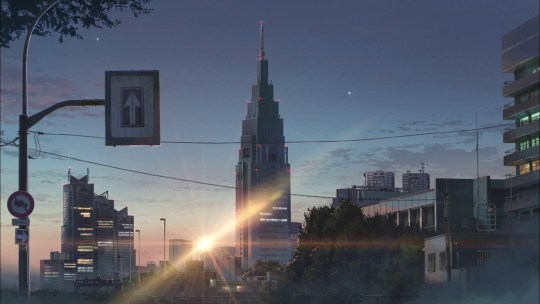
Film ini sangatlah terkenal sampai dijadwalkan untuk rilis di 92 negara, termasuk Indonesia pada tanggal 7 Desember 2016 lalu. Pendapatan kotor dari film ini pun lebih dari 20 milyar yen, menempatkan sebagai film animasi kedua Jepang terpopuler setelah “Spirit Away”. Kimi no Na wa juga hampir menjadi calon nominasi film animasi terbaik dalam gelaran oscar 2017.
Jadi, tidak akan rugi melihat film ini, tapi lebih baik lihat di bioskop karena kalian akan merasakan wow lihat visualisasinya.
Rating imbd: 8,7/10
Sumber: http://i.imgur.com/Uqw37Sk.jpg
https://www.kreasitekno.com/wp-content/uploads/2016/10/anime-terbaik-buatan-makoto-shinkai-kimi-no-na-wa.jpg
https://joshuaagar.files.wordpress.com/2016/10/kimi-no-na-wa-gif.gif?w=540&h=302
https://fastjapan.com/en/wp-content/uploads/2016/09/43.png
https://www.suyongso.com/files/attach/images/115/623/348/014/c01142594425a3fbae5da56c1fcc909c.jpg
5 notes
·
View notes
Text
A Declaration: after months of being in denial, I now acknowledge mine and @seokjinssi 's shared string of fate. Here, t, idc if it's -5°C of 35°C, wear the scarf I made you or I'll spit in your kuchikamisake 😘🥰
3 notes
·
View notes
Photo

My copy of Your Name didn't turn up, but my bro brought over his copy so we watched it and ate some Taki and Mitsuha sweets that I bought back in Spring. It's rare that I had such appropriately themed snacks 😂 No kuchikamisake though...
0 notes
Text
I’ve probably rewatched the climb to Musubi’s Shrine scene and the kuchikamisake trip scene about a dozen times and I still get goosebumps. The combination of music and the visuals is just breathtaking.
0 notes
Photo

— Shinto Shrine 🌅 Again, Kimi No Na Wa reference. Not the exact arc, but this reminds me of the shrine where Mitsuha Miyamizu and her sister conducted the ceremony for Kuchikamisake 😅 (at Kasuga-taisha)
0 notes